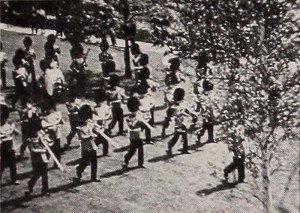
"In Streets of Peace, Lewis B. Sebring, jr., presents a manifold accomplishment in film. Here is a record of the New York World's Fair 1939, but a record which, because of its selectivity, gives the impression of completeness in setting forth a single theme, although the material is both voluminous and varied. Here, also, is an interpretation of the epic idea behind the foreign participation in this great American exposition, the vision of peace, which has since been so rudely interrupted. Mr. Sebring takes his camera through the streets of peace, literally, and we see one after another of the foreign buildings and exhibits at the Fair; we also look at the different national celebrations in the Court of Peace. The visit of the King and Queen of England is recorded in considerable detail. After a scene of children of many lands uniting in a gathering in the Children's World, we find the pointed query as to what these youngsters will make of the "world of tomorrow," and the picture closes with distinguished shots of the United States Building, with its flag and the word "Peace," which appears on its façade. Mr. Sebring's titling is admirable, both in wording and in execution. His Kodachrome exposures have less good moments, but his camera handling is otherwise pleasing. Here is a workmanlike and finished recording of a great international event." Movie Makers, Dec. 1939, 635-636.
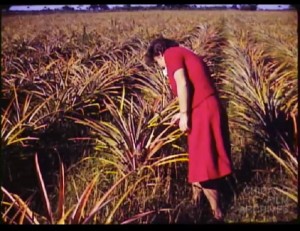
"2 part edited travelogue of the industries and everyday life in featured cities of Cuba. Part 1 begins in Havana before travelling to smaller cities, with a focus on buildings, crops and the everyday lives of the people. Part 2 primarily focuses on industry and includes scenes of a tile factory, basket weaving, as well as the farming of potatoes, sugar cane, bananas, and peanuts. The film also features historical monuments, boating, children at school, cock fights, vendors selling wares, and fishing. People demonstrate manual methods of labor like harvesting crops and cutting grass with machines lead by cattle." Chicago Film Archives.
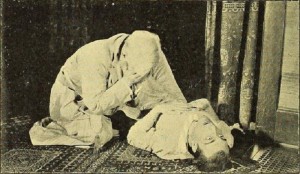
"The production of the Flower City Amateur Movie Club of Rochester, N. Y., Terror, 400 ft., 16mm., was written and directed by Frank J. Buehlman. It was recently screened as a special, added feature on a week's run at the Little Theater in Rochester. Terror is a psychological study of the effect of fear. Its story is based on a practical joke engineered by friends of the victim who, to the end of the film, remain ignorant of the disastrous results. As the story develops, we see the commonplace incidents of every day life through the eyes of the fear obsessed principal character. The handling of the theme required great care but the producers succeeded in making the highly fantastic reactions of the character seem plausible. With its exquisite lighting effects and the dramatic power achieved in the climactic sequences through cinematography, this film is certainly outstanding." Movie Makers, Dec. 1930, 759.
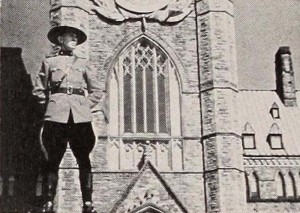
"Sweeping in its conception, stirring in its execution, Then Came the King is a vivid and beautiful epic of honest patriotism. In it, Earl L. Clark has examined the Western way of life, and he has found it good. With elaborate but never exhausting detail, the film traces the history of Canada — and more briefly her American neighbor — from 1800 to the present day. Then, in a world challenged by war and a Canada accused of waning fealty to the Empire, Then Came the King pictures with a magnificent climax the deep and unfaltering affection in which a loyal people hold their rulers. People of all classes and occupations are shown saluting Their Majesties. Sensitively planned and superbly titled, the film very definitely has something to say — and says it with distinction. Viewpoint after viewpoint strikes sensuously on the eye as exactly right for the effect desired. Sequence after sequence marches down the screen with the brave and stirring rhythms of epic poetry. On a few occasions, Mr. Clark's striking imagination has outstripped his straining technical skill, but. from his first frame to his last, the work is stamped unerringly with a fresh and genuine creative spirit." Movie Makers, Dec. 1939, 632.
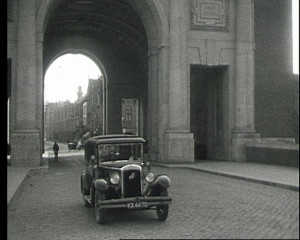
(Reel 1) - "First in a series of eight film reels recording Eustace and Eunice Alliott’s trip to and from the Oberammergau Passion Play in 1930, by way of a motor tour through Belgium, Luxembourg and the Rhine, before travelling further south to northern Italy, Liechtenstein and Switzerland, returning to London via Germany and Belgium. The first reel in this series records details of Alliotts' journey through Belgium and Luxembourg. Scenes include: visits to war memorials and observations of activities of local inhabitants. The visits to war memorials notably emphasise connections or interests that Eustace Alliott might have had or felt towards the sacrifices made by engineers or men from Lancashire. Scenes include: the Alliotts' car being loaded on to a ferry at Dover; shots of Ypres, notably the ruins of the Cloth Hall, the Menin Gate and market scenes near the Cloth Hall; visits to war memorials near Ypres, including Hill 60, Zillebeke, the Tyne Cot cemetery and the church at Passchendaele; the journey through Belgium including visits to Courtrai, Tournai, Mons and Namur, where the Alliotts' record celebrations of the centenary of Belgian independence; the journey by the Rivers Sambre and Meuse including their visits to Old Dinant and Chateau de Walzin; and time spent in in the gardens, streets and alleys of Luxembourg. Shots at Belgian war memorials include: a visit to the Hill 60 war memorial, where Eunice, along with members of the Farnham girl guides, inspect a concrete bunker; walk through and inspect a trench at Zillebeke, including a shot of the trench and abandoned munitions (trench now filled in, see http://www.ww1battlefields.co.uk/flanders/hill60.html); a visit to the Tyne Cot cemetery where Eunice inspects the inscription at the base of the Great Cross, including a clear shot of the inscription that has since been corrected (it reads captured by 2nd Australian Division [now corrected to 3rd Australian Division] 24 October 1917); at Tyne Cot Eunice walks past and looks at the Tyne Cot Memorial to the Missing; there is a shot of a headstone of one of the unidentified servicemen of the Royal Engineers; by the side of a road Eunice retrieves a discarded helmet; there is a shot of the Passchendaele church window memorial to British dead from “Duchy of Lancaster”. Shots at Namur for the centenary celebration of Belgian independence include: a procession of soldiers and dignitaries; Eunice with members of a Pierrot troupe, including shots of the troupe in a street procession." (EAFA Database)
(Reel 2) - "Second in a series of film reels recording Eustace and Eunice Alliott’s trip to and from the Oberammergau Passion Play in 1930, by way of a motor tour through Belgium, Luxembourg and the Rhine, before travelling further south to northern Italy, Liechtenstein and Switzerland, returning to London via Germany and Belgium. The second reel in this series records details of Alliotts' journey from Trier along the Moselle and Rhine river valleys [through the demilitarised area of Germany established by the Treaty of Versailles] to Bensheim. Scenes include: tourist attractions and observations of activities of local inhabitants. Shots of tourist attractions include: historic monuments in Trier; a visit to a Traben vineyard; castles along the Moselle and Rhine valleys; the Wilhelm I monument in Koblenz. Shots of local activities include: the market places in Trier and Bernkastel; agricultural labourers in the Moselle valley transporting hay; women and children bleaching linen by the side of the river in Bernkastel; agricultural labourers using ferries near Traben and fruit being picked along the road; river traffic on the Rhine at Koblenz with particular emphasis on the operation of a bridge consisting of boats. The reel concludes with a record of the Corpus Christi street celebrations in Bensheim. Many of the scenes include Eunice Alliott, who walks or drives into shot, or interacts with local inhabitants, or perhaps has persuaded individuals to pose for the camera, such as children at the Roman Basilica in Trier and a two man band in Stoltzenfels." (EAFA Database)
(Reel 3) - "Third in a series of film reels recording Eustace and Eunice Alliott’s trip to and from the Oberammergau Passion Play in 1930, by way of a motor tour through Belgium, Luxembourg and the Rhine, before travelling further south to northern Italy, Liechtenstein and Switzerland, returning to London via Germany and Belgium. The third reel in this series records details of Alliotts' journey from Heidelburg through the Neckar valley and Bavaria to Oberammergau, including shots of Oberammergau and the surrounding mountains. Scenes include: visits to historic monuments and tourist attractions as well as observations of the activities of local inhabitants. Notably, the film reel includes a day out with unidentified friends in Heidelberg and perhaps inadvertently a shot of the presence and activities of the national socialist party in and near Heidelberg.
Shots of tourist attractions and historic monuments include Heidelberg Cathedral and square, including a building with the sign ‘National Sozialistische Deutsche Arbeitespartei’; Heidelberg castle; river cruise boats at Neckargemünd; Ulm cathedral; and as the Alliotts' approach Oberammergau shots of the landscape. Shots of the activities of local inhabitants include: children playing by the river at Neckargemünd; a youth rambling group in the Neckar Valley; street scenes in Neckarsulm and a fair outside Ulm cathedral; street scenes in Oberammergau, highlighting the numbers of tourists in the village for the passion play. Many of the scenes include Eunice Alliott, who walks or drives into/ out of shot, such as watching a steam tug on the Neckar or admiring the view at Schongau or leaving Neckarsulm. Both Eustace and Eunice Alliott appear in shot during the picnic at Heidelberg. Notably Eustace Alliott appears in shot at Heidelberg, Schongau and possibly once driving the Austin Sixteen. Eustace Alliott also features in the section following the intertitle ‘Part II – Oberammergau, June 1930’, appearing mountain walking near the Kofel mountain and mountains overlooking Oberammergau." (EAFA Database)
(Reel 4) - "Fourth of a series of film reels recording Eustace and Eunice Alliott’s trip to and from the Oberammergau Passion Play in 1930, by way of a motor tour through Belgium, Luxembourg and the Rhine, before travelling further south to northern Italy, Liechtenstein and Switzerland, returning to London via Germany and Belgium. The fourth reel in this series records details of Alliotts' stay in Oberammergau, focusing on the 1930 Passion Play and their interaction with key members of the cast. Shots include: women washing and drying laundry away from the main streets; the Alliotts' accommodation and host; crowds outside the theatre; official photographs of the production; audience and actors leaving auditorium; meetings with key actors in the production, notably Anton Lang (Prologue) with Eunice; Alois Lang (Christ), Anni Rutz (Mary) with Eunice; Johanna Preisinger (Magdelene); unidentified actor (John); Guido Mayr (Judas) with Eunice." (EAFA Database)
(Reel 5) - "Fifth of a series of film reels recording Eustace and Eunice Alliott’s trip to and from the Oberammergau Passion Play in 1930, by way of a motor tour through Belgium, Luxembourg and the Rhine, before travelling further south to northern Italy, Liechtenstein and Switzerland, returning to London via Germany and Belgium. The fifth reel in this series records details of Alliotts' journey through the Tyrol in Austria, and Italy. The records details of the Alpine scenery and observations of the activities of the inhabitants in the Tyrol, with a particular fascination with agricultural labour and the work of women. Shots include: the Alliotts leaving Oberammergau; flags in Mittenwald celebrating the ‘freeing’ of the Rhine; alpine landscapes in the Tyrol at Seefeld, Reith im Alpbachtal, Lanser Kopfe, Hafelekar, Serles, Vipeteno, Lake Misurina, Croci Pass and Monte Piana; agricultural and rural labour in the Tyrol; women washing laundry in a village in the Stubaithal; road construction near Misurina; the Austin Sixteen off the road ascending Monte Piana, assistance provided by Austrian motorists." (EAFA Database)
(Reel 6) - "Sixth in a series of film reels recording Eustace and Eunice Alliott’s trip to and from the Oberammergau Passion Play in 1930, by way of a motor tour through Belgium, Luxembourg and the Rhine, before travelling further south to northern Italy, Liechtenstein and Switzerland, returning to London via Germany and Belgium. The sixth reel in this series records details of Alliotts' journey through northern Italy from the Dolomites to Lake Como. Scenes include: landscape shots of mountain peaks (including the Dolomites, and mountain peaks at the Stelvio Pass); observations of the local population and activities (including children, villagers, and soldiers who pose for the camera in the Dolomites; village street scenes in the Karerpass [Costalunga Pass]; agricultural labourers engaged in harvesting; fishing on Lake Como; and the progress of road improvements around Lake Como); a stop at a roadside war memorial in the Karerpass and in the Stelvio Pass Eunice examines reminders of war found by the roadside; visits to local sightseeing attractions on Lake Como, as well as boat trip on the lake. Notably, as in other reels, the scenes in this film record work done by women as part of the agricultural workforce and in domestic duties, with shots of women engaged in harvest work and washing laundry." (EAFA Database)
(Reel 7) - "Seventh in a series of film reels recording Eustace and Eunice Alliott’s trip to and from the Oberammergau Passion Play in 1930, by way of a motor tour through Belgium, Luxembourg and the Rhine, before travelling further south to northern Italy, Liechtenstein and Switzerland, returning to London via Germany and Belgium. The seventh reel in this series records details of Alliotts' journey from northern Italy to Switzerland, passing through Liechtenstein. Scenes include: sightseeing in Milan; mountain walks at the Morteratsch glacier and in the Bernina Pass in Switzerland; a stop at a fortified border post in Liechtenstein; sightseeing at Vaduz castle; a meeting with a female peddler; a street scene in Altdorf; views of Lake Lucerne; and a visit to the Rhone glacier. Shots of local sightseeing attractions in Milan include Galleria Vittorio Emanuele and Milan Cathedral; street scenes outside the cathedral; Eunice tours the roof of Milan Cathedral; pan shot from roof over Milan; Eunice walks in the gardens at Santa Maria delle Grazie. Shots in the Alps include Eustace observing the view at the Morteratsch glacier; mountain scenery at the Bernina Pass; views from and in the castle at Vaduz; a peddler in Clausen Pass; female swineherds; the fountain at Altdorf, the river at Andermatt; the Rhone glacier with shots of Eunice walking on the glacier and with other tourists at an ice cavern, as well as of the valley below glacier and the glacier from valley." (EAFA Database)
(Reel 8) - "Final reel (in a series of eight) recording Eustace and Eunice Alliott’s trip to and from the Oberammergau Passion Play in 1930, by way of a motor tour through Belgium, Luxembourg and the Rhine, before travelling further south to northern Italy, Liechtenstein and Switzerland, returning to London via Germany and Belgium. The final reel in this series records details of the Alliotts' return journey from Switzerland through Germany and Belgium to London. Scenes include: unusual sights encountered on the road, records of visits to areas of scenic beauty and sightseeing tours in towns and cities, as well as observations of the activities of local inhabitants. Shots include: an encounter with cattle on the road in Switzerland; waterfalls at the Handegg and Rhine Falls; lumber being moved near Titisee; street scenes at Freiburg, including shots of the market near the cathedral and shots of people wearing traditional clothing; sights in Baden-Baden, Worms, Frankfurt, Louvain and Ghent, including the Luther Memorial, market place in Frankfurt and Van Eyck Monument; observations of activities in Ghent, including a boat being unloaded. The film concludes with a shot of the fountains in Trafalgar Square. Notably, on their return visit to Koblenz the Alliotts' obtain shots of a rehearsal for a visit by Hindenburg, on the Deutches Eck, including a long shot of a small group of national socialists amongst the crowd who perform a salute. Shots also reflect the Alliotts' interest in mechanical engineering (the ferry across the Rhine near Karlsruhe) and dogs (Ghent and Bruges)." (EAFA Database)
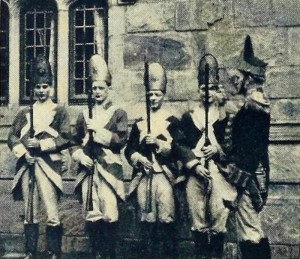
"Tom Jones, about 5000 ft., 16 mm, produced by the Purity Players of Yale University under the direction of S. Winston Childs, is the first amateur super-feature. The story is based on Fielding's Tom Jones and adheres with remarkable faithfulness to this famous novel, while many of the sets and costumes exhibit a care and an historical accuracy that has not since been equaled in amateur work. To those who have interest in 18th century literature, the picture will be particularly valuable." Movie Makers, Sept. 1930, 569.
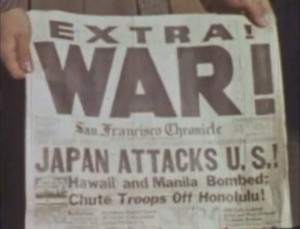
"Amateur film footage shot by Dave M. Tatsuno while he was interned at the Topaz War Relocation Center, the Japanese-American internment camp located in Delta, Utah. The footage dates from 1942-1945, the years that Tatsuno was interned in the camp." Archives West.
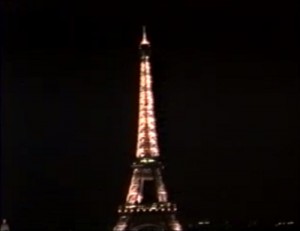
"In September 1992, Robbins Barstow and his wife Meg, of Wethersfield, Connecticut, USA, celebrated their 50th Wedding Anniversary by spending ten days visiting their son David and his family in Paris, France. Their two grandchildren, Geoffrey and Suzanna, showed them the sights of the city of lights, including the Eiffel Tower, Arc de Triomphe, Notre Dame Cathedral, Grand Opera House, and the Louvre." Archive.org
"Item is a film production of Dr. Willinsky's trip to Trinidad with his wife, Sadie. Filmed in the form of a travelogue, Willinsky intersperses footage of landmarks and the local population with captions that provide information about the country and its culture. Included are shots of sites around Port-of-Spain, cathedrals, mosques, a cricket match, a cocao bean farm, and the local population carrying out their daily activities. Sadie is regularly spotted sight-seeing and interacting with locals." Ontario Jewish Archives.
"The story… opens in the sixteenth century with a scene showing the friendly relations between two neighbouring families as indicated by Roger de Hatherley and Richards Hawkins fishing the trout stream dividing their respective estates. Next we are shown their descendants at war over the fishing rights of the same stream, a family feud begins, and a love story which, although it does not run smoothly, ends happily" (Lovell Burgess 1932: 11).
Total Pages: 15